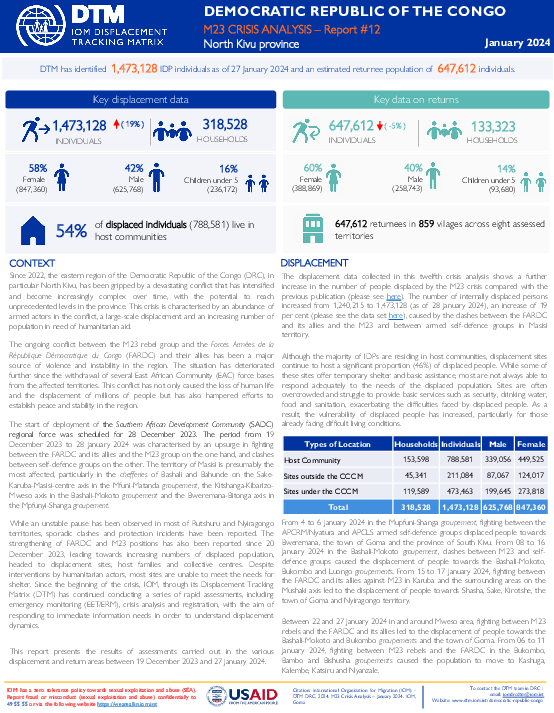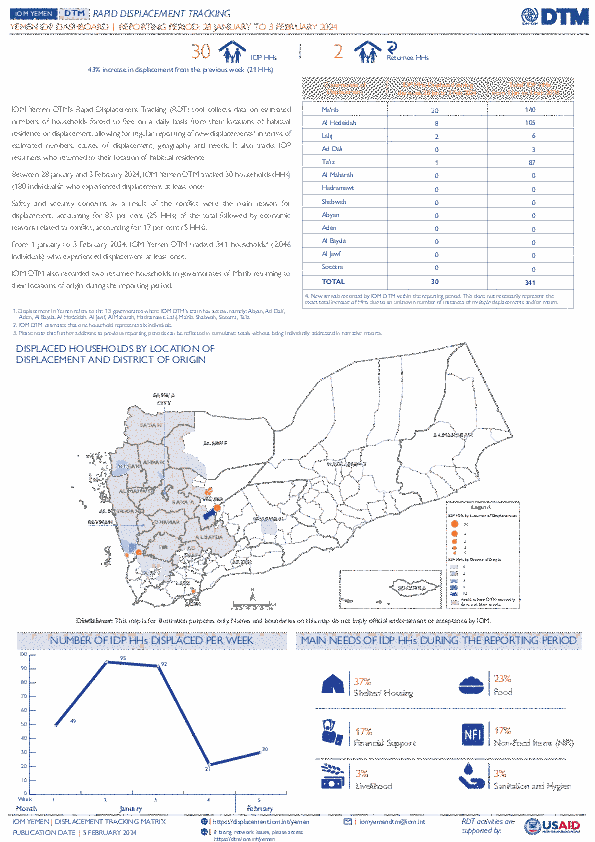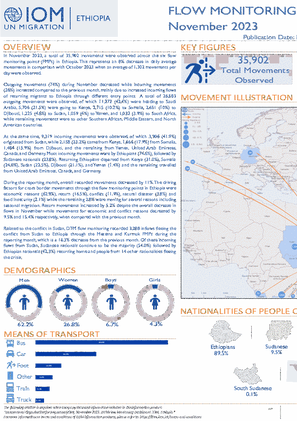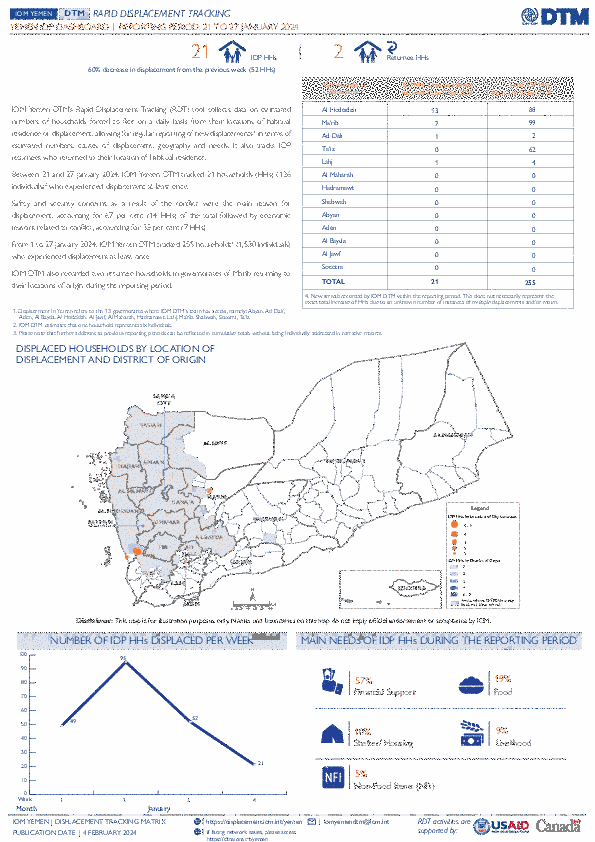-
Countries
-
Data and Analysis
-
Special Focus
-
Crisis Responses

Contact
DTM Sudan; dtmsudan@iom.int
Language
English
Location
Sudan
Period Covered
Jan 26 2024
Feb 02 2024
Activity
- Mobility Tracking
- Baseline Assessment
Overview
From 15 April 2023, armed clashes erupted between the Sudanese Armed Forces (SAF) and the Rapid Support Forces (RSF) in multiple cities across Sudan. Clashes initially took place in cities across Northern and Khartoum states, later spreading across the Darfur and Kordofan regions.
Highlights
- DTM Sudan estimates that 6,144,363 (1,224,269 Households) were recently internally displaced.
- The IDP caseload was observed in 6,594 locations across all of Sudan’s 18 states.
- The highest proportions of IDPs were observed across South Darfur (12%), River Nile (11%), East Darfur (11%), White Nile (8%), North Darfur (8%), Northern (7%), and Sennar (7%).
- Field teams reported that the IDPs observed were originally displaced from twelve states. The majority (3,522,784 IDPs, 57%) were reportedly displaced from Khartoum state; followed by South Darfur (15%), North Darfur (8%), Aj Jazirah (7%), Central Darfur (4%), West Darfur (3%), East Darfur (1%), South Kordofan (1%), West Kordofan (<1%), North Kordofan (<1%), Sennar (<1%), and White Nile (<1%).
- IOM-DTM also reported that an estimated 1,780,295 mixed cross-border movements were made into neighbouring countries.
- This product provides brief insights into those displaced in Sudan post-15 April 2023. For more granular information on the IDP caseload and the displacement context, please see IOM-DTM's Monthly Displacement Overview (05).
Feb 07 2024
Print
Duty Station
Islamabad, Pakistan
Number of positions
1
Starting Date
2024-01-25
Type
Consultant
Closing Date
2024-02-11
Status
Open
Duration
Six months (extendable)
Project Context and Scope:
Established in 1951, IOM is the leading inter-governmental organization in the field of migration and works closely with governmental, intergovernmental and non-governmental partners. IOM is dedicated to promoting humane and orderly migration for the benefit of all. It does so by providing services and advice to governments and migrants.
The Displacement Tracking Matrix (DTM) is a system to track and monitor displacement and population mobility, and is designed to regularly and systematically capture, process and disseminate information providing a better understanding of the movements and evolving needs of displaced populations, whether on-site or enroute. In recent years DTM has become increasingly recognized as the primary source of displacement and migration data and information sources at country, regional and global levels. As a result of its worldwide presence, flexibility, and interoperability, DTM is now being implemented in Pakistan.
Organizational Department / Unit to which the Consultant is contributing:
The Consultant will be contributing to IOM’s Displacement Tracking Matrix (DTM) programme. One of the core functions of DTM is data collection targeting various types of mobile populations and communities living with them through various methods such as face-to-face and/or telephonic interviews. Several enumerators and field coordination assistants will be assigned to conduct data collection and coordinate the effort at the field level.
- Category A Consultants: Tasks to be performed under this contract
Under the overall supervision of the Displacement Tracking Matrix (DTM) Programme Manager in IOM Pakistan, the incumbent will be supporting the implementation of the IOM DTM programme in Pakistan, including:
- Support with the implementation of DTM activities in Pakistan including but not limited to; DTM BaselineMobility Assessments, DTM Community Needs Assessments, DTM Flow Monitoring, DTM Thematic Surveys.
- Support with DTM data analysis and reporting, including (but not limited to) the development of DTManalytical reports, dashboards and sitreps.
- Contribute to cross-sectoral and thematic analyses of interest to IOM and partners, including on humanmobility in the context of climate change, migrant protection, vulnerabilities, and needs.
- Actively participate in the process of generating visualizations products such as interactive dashboards,maps, charts, and infographics that show findings, summarized and customized information to present tomanagement, advocacy teams, other organization's departments, donors, and for data quality control.
- Design and develop DTM forms, using KOBO Toolbox and participate in the revision of the tools.
- Support the unit in determining operational feasibility of new software requirements and implementsolutions by determining and designing system specifications, standards, and programming.
- Support the development and implementation of software development Standard Operating Procedures(SOPs) on establishing source control, continuous integration, deployment, and issue tracking.
- Monitor the quality of collected data, provide feedback regarding any inconsistencies, and support datacleaning and analysis as needed.
- Recommend areas for improvements and propose solutions to improve data collection, effectiveness, andefficiency of the methodology and the processes to maximize performance and contextualization of DTMfield activities.
- Support back-up and organization of all data and information sources (hard copy, soft copy).
- Support with the development and implementation of trainings and workshops to DTM staff, enumeratorsand external partners where needed, and this includes sessions on DTM’s methodology and assessmenttools, data processing protocols, data protection principles, definitions etc.
- Ensure the integration of gender perspectives and attention to specific women/girls and children’s rightsissues (vulnerable groups) within all DTM activities.
- Ensure operational implementation compliance with IOM Data Protection Policy, IOM Data GovernancePolicy, IASC Operational Guidance on Data Responsibility in Humanitarian Action, and the ethicalconsideration on humanitarian data operations.
- In coordination with the DTM Programme Manager, liaise with relevant authorities, UN agencies, NGOs,think tanks, government authorities, and other stakeholders on issues relevant to DTM projects. Participatein relevant meetings where assigned.
- Perform other duties such as assigned by the direct supervisor.
Performance indicators for the evaluation of results:
1. Number of reports edited or finalized.
a.Target: 10 reports for 6 months
2. Number of databases maintained and improved for accuracy and completeness.
a.Target: 2 databases for 6 months
3.Number of data collection tools developed.
a. Target: 2 data collection tools developed for 6 months
Education, Experience and/or skills required:
EDUCATION
- Bachelor’s degree from an accredited academic institution, preferably in Public Relation, Social Sciences,or relevant fields
- Master’s degree in relevant subjects is an advantage.
EXPERIENCE
- At least 2 years of relevant working experience.
- Prior experience in coordination of the field teams, preferably for research and data collection.
- Experience with data collection and verification.
- Experience working in the same local context.
- Experience working with local government representatives.
- Prior experience working for UN agency or international organization is an advantage
SKILLS
- The ability to plan and coordinate activities effectively, especially in data collection and analysis.
- Practical experience of how-to multi-task prioritize and work independently.
- Basic data cleaning and verification skills.
- Strong written and verbal communication skills for interaction with various stakeholders anddocumentation.
- Ability to work effectively and harmoniously in a team of colleagues of varied cultural and professionalbackgrounds.
- Proven ability to produce quality work accurately and concisely according to set deadlines
TRAVEL REQUIRED
- Travel to Islamabad, Pakistan preferred, with the option for periods of working from home station whilst awaiting visa (renewal).
Competencies
Values
- Inclusion and respect for diversity: respects and promotes individual and cultural differences. Encouragesdiversity and inclusion.
- Integrity and transparency: maintains high ethical standards and acts in a manner consistent withorganizational principles/rules and standards of conduct.
- Professionalism: demonstrates ability to work in a composed, competent and committed manner andexercises careful judgment in meeting day-to-day challenges.
- Courage: demonstrates willingness to take a stand on issues of importance.
- Empathy: shows compassion for others, makes people feel safe, respected and fairly treated.
Core Competencies – behavioural indicators
- Teamwork: develops and promotes effective collaboration within and across units to achieve shared goalsand optimize results.
- Delivering results: produces and delivers quality results in a service-oriented and timely manner. Is actionoriented and committed to achieving agreed outcomes.
- Managing and sharing knowledge: continuously seeks to learn, share knowledge and innovate.
- Accountability: takes ownership for achieving the Organization’s priorities and assumes responsibility forown actions and delegated work.
- Communication: encourages and contributes to clear and open communication. Explains complex mattersin an informative, inspiring and motivational way.
SUBMISSION OF PROPOSALS
Method of Application:
Interested Candidates are invited to submit your application by 11th February 2024 through e-mail to: IOMIslamabadrecruitment@iom.int mentioning the “Call for Applications, IM and Reporting Consultant” in subject line. Please keep the attachment size under 9 MB.
The application should be written in English. Applications should include:
- Cover letter
- Curriculum vitae
Other:
The appointment is subject to funding confirmation. Appointment will be subject to certification that the candidate is medically fit for appointment, accreditation, any residency or visa requirements, and security clearances. No late applications will be accepted.

Contact
DTM DRC, iomdrcdtm@iom.int
Language
English
Location
Democratic Republic of the Congo
Period Covered
Dec 19 2023
Jan 27 2024
Activity
- Mobility Tracking
- Event Tracking
Since 2022, the eastern region of the Democratic Republic of the Congo (DRC), in particular North Kivu, has been gripped by a devastating conflict that has intensified and become increasingly complex over time, with the potential to reach unprecedented levels in the province. This crisis is characterised by an abundance of armed actors in the conflict, a large-scale displacement and an increasing number of population in need of humanitarian aid.
The ongoing conflict between the M23 rebel group and the Forces Armées de la République Démocratique du Congo (FARDC) and their allies has been a major source of violence and instability in the region. The situation has deteriorated further since the withdrawal of several East African Community (EAC) force bases from the affected territories. This conflict has not only caused the loss of human life and the displacement of millions of people but has also hampered efforts to establish peace and stability in the region. Since the beginning of the crisis, IOM, through its Displacement Tracking Matrix (DTM) has continued conducting a series of rapid assessments, including emergency monitoring (EET/ERM), crisis analysis and registration, with the aim of responding to immediate information needs in order to understand displacement dynamics. This report presents the results of assessments carried out in the various displacement and return areas between 19 December 2023 and 27 January 2024.

Contact
DTM DRC, iomdrcdtm@iom.int
Language
French
Location
Democratic Republic of the Congo
Period Covered
Dec 19 2023
Jan 27 2024
Activity
- Mobility Tracking
- Event Tracking
Depuis 2022, la région orientale de la République démocratique du Congo (RDC), en particulier le Nord-Kivu, est en proie à un conflit dévastateur qui s'est intensifié et est devenu de plus en plus complexe au fil du temps, avec le potentiel d'atteindre des niveaux sans précédent dans le Nord-Kivu. Cette crise se caractérise par une multitude d'acteurs armés en conflit, une importante population déplacée et une population encore plus importante en manque d'aide humanitaire. Le conflit actuel entre le groupe rebelle M23 et les Forces armées de la République démocratique du Congo (FARDC) et leurs alliés a été une source majeure de violence et d'instabilité dans la région. La situation s'est encore détériorée depuis le début du retrait de plusieurs bases des forces de la Communauté de l'Afrique de l'Est (CAE) des territoires affectés. Ce conflit a non seulement causé la perte de vies humaines et le déplacement de millions de personnes, mais il a également entravé les efforts visant à instaurer la paix et la stabilité dans la région.
Depuis le début de la crise, l'OIM, par le biais de la DTM continue à mener une série d'évaluations rapides, y compris le suivi des urgences (EET/ERM), l'analyse des crises et enregistrement avec priorité de répondre aux besoins immédiats d'information en vue de comprendre la dynamique des déplacements et les besoins. Ce rapport présente les résultats des évaluations menées dans les différentes zones de déplacement et de retour du 19 décembre 2023 au 27 janvier 2024.

Contact
RDH Asia and the Pacific Support - rdhroapsupport@iom.int
Language
English
Location
Afghanistan
Period Covered
Aug 15 2021
Aug 15 2023
Activity
- Flow Monitoring
From when the reporting period started to where it ends, (15 August 2021 to 15 August 2023), the gap between total outflows and inflows has dwindled between Afghanistan and two of its neighbouring countries, that is the Islamic Republic of Iran and Pakistan.
By the second half of the reporting period, cross-border movements reached close to a 1 to1 ratio between outflows (4,307,755) and inflows (4,314,442).
Changes in these flows across this two year period may be more generally attributed to the combination of tighter governmental controls on border crossings, temporary border closures, and fear of deportations of Afghan nationals living abroad. The following sections point to notable peaks and downturns in mobility flows to help put into perspective the timeline and context in which IOM operates in.
Contact
DTM Yemen, iomyemendtm@iom.int
Location
Yemen
Activity
- Mobility Tracking
- Event Tracking
Period Covered
Jan 28 2024 -Feb 03 2024
From 1 January to 3 February 2024, IOM Yemen DTM tracked 341 households (HH) (2,046 Individuals) who experienced displacement at least once.
Between 28 January and 3 February 2024, IOM Yemen DTM tracked 30 households (180 individuals) displaced at least once. The majority of people moved into/within the following governorates and districts:
- Ma’rib (20 HHs) – Harib (11 HHs), Marib City (7 HHs), Marib (2 HHs) districts. Most displacements in the governorate originated from Marib and Ta’iz.
- Al Hodeidah (8 HHs) – Hays (5 HHs), Al Khukhah (3 HHs) districts. Most displacements in the governorate were internal.
- Lahj (2 HHs) – Tuban (2 HHs) district. Most displacements in the governorate originated from Ta’iz and Al Hodeidah.
The majority of people moved from the following governorates and districts:
- Ma’rib (12 HHs) – Harib (12 HHs) district.
- Al Hodeidah (8 HHs) – Al Jarrahi (3 HHs), At Tuhayta (2 HHs), Al Hali (1 HH) districts.
- Ta’iz (4 HHs) – At Taiziyah (1 HH), Maqbanah (1 HH), Al Mawasit (1 HH) districts.
Population Groups
Survey Methodology
Unit of Analysis Or Observation
Type of Survey or Assessment
Keywords
Geographical Scope
Administrative boundaries with available data
The current dataset covers the following administrative boundaries

Contact
DTM Yemen, iomyemendtm@iom.int
Language
English
Location
Yemen
Period Covered
Jan 28 2024
Feb 03 2024
Activity
- Mobility Tracking
- Event Tracking
IOM Yemen DTM’s Rapid Displacement Tracking (RDT) tool collects data on estimated numbers of households forced to flee on a daily basis from their locations of origin or displacement, allowing for regular reporting of new displacements in terms of estimated numbers, geography, and needs. It also tracks returnees who returned to their location of origin.
|
From 1 January to 3 February 2024, IOM Yemen DTM tracked 341 households (HH) (2,046 Individuals) who experienced displacement at least once. Between 28 January and 3 February 2024, IOM Yemen DTM tracked 30 households (180 individuals) displaced at least once. The majority of people moved into/within the following governorates and districts: |
- Ma’rib (20 HHs) – Harib (11 HHs), Marib City (7 HHs), Marib (2 HHs) districts. Most displacements in the governorate originated from Marib and Ta’iz.
- Al Hodeidah (8 HHs) – Hays (5 HHs), Al Khukhah (3 HHs) districts. Most displacements in the governorate were internal.
- Lahj (2 HHs) – Tuban (2 HHs) district. Most displacements in the governorate originated from Ta’iz and Al Hodeidah.
The majority of people moved from the following governorates and districts:
- Ma’rib (12 HHs) – Harib (12 HHs) district.
- Al Hodeidah (8 HHs) – Al Jarrahi (3 HHs), At Tuhayta (2 HHs), Al Hali (1 HH) districts.
- Ta’iz (4 HHs) – At Taiziyah (1 HH), Maqbanah (1 HH), Al Mawasit (1 HH) districts.
IOM identified 56 households displaced in the previous reporting period, which covered 21 - 27 January 2024, in the governorates of Ta’iz (25 HHs), Ma’rib (21 HHs), Al Hodeidah (9 HHs), and Ad Dali (1 HH). These figures have been added to the cumulative displacement total recorded since the beginning of the year.

Contact
DTM Ethiopia, DTMEthiopia@iom.int
Language
English
Location
Ethiopia
Period Covered
Nov 01 2023
Nov 30 2023
Activity
- Flow Monitoring
In November 2023, a total of 35,902 movements were observed across the six flow monitoring points (FMPs) in Ethiopia. This represents an 8% decrease in daily average movements in comparison with October 2023 when an average of 1,302 movements per day were observed.
Outgoing movements (74%) during November decreased while incoming movements (26%) increased compared to the previous month, mainly due to increased incoming flows of returning migrants to Ethiopia through different entry points. A total of 26,583 outgoing movements were observed, of which 11,272 (42.4%) were heading to Saudi Arabia, 5,706 (21.5%) were going to Kenya, 2,715 (10.2%) to Somalia, 2,651 (10%) to Djibouti, 1,225 (4.6%) to Sudan, 1,059 (4%) to Yemen, and 1,032 (3.9%) to South Africa, while remaining movements were to other Southern African, Middle Eastern, and North American countries.
At the same time, 9,319 incoming movements were observed, of which 3,906 (41.9%) originated from Sudan, while 2,158 (23.2%) came from Kenya, 1,666 (17.9%) from Somalia, 1,484 (15.9%) from Djibouti, and the remaining from Yemen, United Arab Emirates, Canada, and Germany. Most incoming movements were by Ethiopians (74.6%), followed by Sudanese nationals (23.8%). Returning Ethiopians departed from Kenya (31.0%), Somalia (24.0%), Sudan (22.5%), Djibouti (21.1%), and Yemen (1.4%) and the remaining travelled from United Arab Emirates, Canada, and Germany.
Contact
DTM Yemen, iomyemendtm@iom.int
Location
Yemen
Activity
- Mobility Tracking
- Event Tracking
Period Covered
Jan 21 2024 -Jan 27 2024
From 1 to 27 January 2024, IOM Yemen DTM tracked 255 households (HH) (1,530 Individuals) who experienced displacement at least once.
Between 21 and 27 January 2024, IOM Yemen DTM tracked 21 households (126 individuals) displaced at least once. The majority of people moved into/within the following governorates and districts. The majority of people moved into/within the following governorates and districts:
- Al Hodeidah (13 HHs) – Hays (11 HHs), Al Khukhah (2 HHs) districts. All displacements in the governorate were internal.
- Ma’rib (7 HHs) – Ma’rib City (6 HHs), Ma’rib (1 HH) districts. Most displacements in the governorate originated from Amran and Ta’iz.
- Ad Dali (1 HH) – Ad Dali (1 HH) district. All displacements in the governorate originated from Sanaa.
The majority of people moved from the following governorates and districts:
- Al Hodeidah Ta’iz (13 HHs) – Hays (7 HHs), Al Hali (2 HHs), Jabal Ras (2 HHs) districts.
- Ta’iz (2 HHs) – At Taiziyah (1 HH), As Silw (1 HH) districts.
- Ibb (2 HHs) – Ar Radmah (1 HH), Al Qafr (1 HH) districts.
Population Groups
Survey Methodology
Unit of Analysis Or Observation
Type of Survey or Assessment
Keywords
Geographical Scope
Administrative boundaries with available data
The current dataset covers the following administrative boundaries

Contact
DTM Yemen, iomyemendtm@iom.int
Language
English
Location
Yemen
Period Covered
Jan 21 2024
Jan 27 2024
Activity
- Mobility Tracking
- Event Tracking
IOM Yemen DTM’s Rapid Displacement Tracking (RDT) tool collects data on estimated numbers of households forced to flee on a daily basis from their locations of origin or displacement, allowing for regular reporting of new displacements in terms of estimated numbers, geography, and needs. It also tracks returnees who returned to their location of origin.
From 1 to 27 January 2024, IOM Yemen DTM tracked 255 households (HH) (1,530 Individuals) who experienced displacement at least once.
Between 21 and 27 January 2024, IOM Yemen DTM tracked 21 households (126 individuals) displaced at least once. The majority of people moved into/within the following governorates and districts. The majority of people moved into/within the following governorates and districts:
- Al Hodeidah (13 HHs) – Hays (11 HHs), Al Khukhah (2 HHs) districts. All displacements in the governorate were internal.
- Ma’rib (7 HHs) – Ma’rib City (6 HHs), Ma’rib (1 HH) districts. Most displacements in the governorate originated from Amran and Ta’iz.
- Ad Dali (1 HH) – Ad Dali (1 HH) district. All displacements in the governorate originated from Sanaa.
The majority of people moved from the following governorates and districts:
- Al Hodeidah (13 HHs) – Hays (7 HHs), Al Hali (2 HHs), Jabal Ras (2 HHs) districts.
- Ta’iz (2 HHs) – At Taiziyah (1 HH), As Silw (1 HH) districts.
- Ibb (2 HHs) – Ar Radmah (1 HH), Al Qafr (1 HH) districts.
IOM identified 40 households displaced in the previous reporting period, which covered 14 - 20 January 2024, in the governorates of Al Hodeidah (26 HHs), Ma’rib (8 HHs), Ta’iz (6 HHs). These figures have been added to the cumulative displacement total recorded since the beginning of the year.